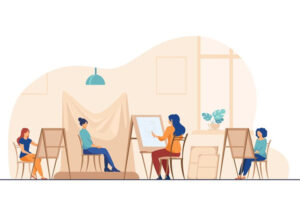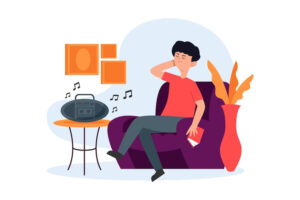In today’s fast-paced world, it is crucial to find effective ways to heal and recharge our overall health. While traditional medical treatments are essential, there are also alternative treatments that can aid in the body’s healing process.
Art therapy and music therapy are two types of therapy that have become known for their ability to reach people on a deep emotional and psychological level.
In this detailed article, we’ll talk about how art therapy and music therapy how it improves our lives.
What is Art therapy?


Art therapy is a type of therapy that uses different kinds of art to help people heal, grow, and feel better about themselves. Art therapy helps people explore their feelings, thoughts, and experiences in a safe and supportive setting by having them paint, draw, sculpt, and do other creative things.
Art therapists are trained professionals who help people understand their feelings and find healthier ways to deal with them by guiding and supporting them through the creative process.
This kind of therapy is especially helpful for people who have trouble talking or have been through a traumatic event. Art therapy doesn’t require special artistic skills because the focus is on the process, not the final product.
People can heal, learn more about themselves, and understand their emotions better through creative expression.
What are the Benefits of Art Therapy?
Art therapy is a powerful and life-changing type of therapy that uses the creative process of making art to improve mental, emotional, and even physical health.
Art therapy gives people a unique way to express their thoughts, feelings, and inner struggles through different art forms.
Let’s know the benefits of Art therapy in someone’s life:
Unlocking Emotional Expression:
Art therapy gives people a safe place to get in touch with their feelings and talk about them without being limited by words. Some people find it hard to say how they feel in words, so art gives them another way to express themselves. Creativity can bring up feelings you’ve been trying to hide, which can help you understand them better.
Stress Reduction and Relaxation:
Stress and anxiety are very common in the fast-paced world of today. Art therapy is a calming and meditative experience that helps people be more aware and less stressed. Making art can lower cortisol levels, which is a hormone that is linked to stress, and make you feel more relaxed.
Enhanced Self-Awareness:
Making art makes you think about yourself and look inside yourself. Through the process of making art, people learn about their thoughts, feelings, and actions. This increased awareness of oneself can lead to personal growth, higher self-esteem, and a better understanding of oneself.
Fostering Problem-Solving Skills:
In art therapy, you often have to work through problems while making art. Finding solutions to problems in art helps you learn how to solve problems in real life. It teaches people to be flexible, adaptable, and able to think outside the box, which can help them in many parts of their lives.
Empowerment and Control:
People feel more independent and in charge of their creative choices when they do art. Art therapy can be especially helpful for people who feel powerless in other parts of their lives because it gives them a sense of control and agency again.
Building Healthy Coping Mechanisms:
Art therapy gives people healthy ways to deal with problems. People can use art as a healthy way to deal with their emotions and stress instead of doing harmful things like drinking or using drugs.
Social Connection and Communication:
Art therapy in a group setting helps people connect and talk to each other. It makes a supportive environment where people can meet others who may be going through the same problems. Group art therapy can help people improve their social skills and feel less alone.
Cognitive Enhancement:
Making art uses different parts of the brain, like problem-solving, memory, and paying attention to details. It can help people with cognitive problems or neurodegenerative diseases like Alzheimer’s improve their thinking skills.
Trauma Processing and Healing:
Art therapy is a good way to help people deal with trauma and heal from emotional wounds. Traumatic events can be brought out into the open and explored through art in a safe and controlled way, which helps the healing process.
Positive Distraction:
Art can be a good way to take your mind off of pain, a long-term illness, or other problems in your life. It takes the focus off of bad things that have happened and puts it on creative expression and personal growth.
Now, what is Music Therapy?



Music therapy is a type of therapy that uses the power of music to help people with their physical, emotional, cognitive, and social needs. It is a whole-person approach in which trained music therapists use music as a tool to help people reach their therapeutic goals and feel better overall.
Music therapy involves doing things that have to do with making music. It is done by playing an instrument, singing, writing lyrics, or making up music on the spot.
People can express themselves and connect with their emotions in a unique and nonverbal way when they do these things.
What are the Benefits of Music Therapy?
Music therapy has a lot of benefits because of how deeply music is connected to the human experience. Let’s look at some of the most important reasons why music therapy works:
Stress Reduction:
Stress can be greatly reduced by listening to soothing music or doing musical things. Music can calm the mind and help you relax, which lowers the amount of stress hormones in your body.
Emotional Expression:
Music is a powerful way to show how you’re feeling. Through music therapy, people can explore and let go of their feelings, which can help them feel better and relieved.
Enhanced Mood:
Music can change your mood and make you feel different things. Music therapists can make playlists that make people feel good. It can be especially helpful for people who are depressed or anxious.
Pain Management:
Endorphins, the body’s natural painkillers, can be released when you listen to music. Music therapy is often used in addition to traditional pain management methods because it is a non-drug way to relieve pain.
Improved Communication:
Music therapy gives people who have trouble talking to others another way to express themselves. They can talk about their thoughts, feelings, and experiences better through music.
Enhanced Cognitive Function:
Music stimulates different parts of the brain, which helps the brain work better and improves memory and learning. This is especially important for people with cognitive problems or conditions that cause nerve cells to die.
Social Interaction:
Group music therapy sessions help people get to know each other and feel like they belong to a group. It gives people a chance to connect with other people who have similar interests and problems.
Increased Motivation:
Music has the power to move and encourage people. In therapeutic settings, music can get people to do more physical activities, improve their motivation to get better, and get them more involved in therapy as a whole.
Promotion of Self-Expression:
Even if a person isn’t a good musician, music therapy helps them be more creative and expressive. This way of expressing yourself can boost your confidence and self-worth.
Anxiety Reduction:
Music can help calm people down and make them feel less anxious. Music therapy techniques, like deep breathing exercises with music, are often used to help people feel less anxious.
How to Incorporate Art and Music Therapy in Daily Life?
Art and music therapy in everyday life can help with overall health and self-expression in many ways.
Here are some practical ways to use art and music therapy in your daily life:
- Morning Art and Music Ritual: Do something creative to start your day. Set aside a few minutes each morning to do simple art activities like doodling, coloring, or sketching. You can also play soothing music or songs that make you feel good to set a good mood for the day.
- Journaling with Music: Combine writing with music to create a therapeutic journaling practice. Play soft instrumental music in the background as you journal about your thoughts, feelings, and experiences. Music can enhance introspection and emotional exploration.
- Create an Art Corner: Set aside a corner of your house for art. Keep art materials like pencils, paints, and clay close at hand. Whenever you want to relax or do something creative, you can go to this designated area.
- Art-Based Mindfulness: Use art to practice being present. Do things like mindful coloring, where you pay attention to the present and lose yourself in the process of making something without judging it.
- Music for Stress Relief: When you’re feeling stressed or anxious, music can help you calm down. Make a playlist of soothing songs or sounds of nature to listen to when you’re feeling stressed.
- Musical Exploration: Explore different kinds of music to expand your musical tastes. Listen to a new song from a genre you haven’t tried before every day. Let yourself feel the feelings and hear the stories that the music is telling.
- Creative Breaks at Work: Take a few minutes during work or study breaks to do quick art activities like drawing or doodling. It can help clear your head and make you more productive.
- Create a Music Playlist for Different Moods: Make your music playlists for different feelings and moods. Have playlists to help you relax, get motivated, feel happy, and think. When you listen to music that fits your mood, it can make you feel better.
- Art and Music for Reflection: Use art and music to help you think about the day when it’s over. Make a picture or song that shows what you did and how you felt that day. This can help you learn more about yourself and grow.
- Art and Music in Nature: Art and music therapy can be done outside. Do plain air painting or just sit in nature and listen to the sounds of the world around you. When nature and creativity come together, it can be refreshing.
Conclusion
There is no doubt that art and music therapy can help people feel better. Both of these creative methods offer different ways to grow as a person, deal with feelings, and find out more about yourself.
Art and music therapy can help you heal and be happier, whether you’ve been through a traumatic event, want to feel better emotionally, or just want to improve your everyday life.
FAQs on Art and Music Therapy
Q: Who can benefit from art and music therapy?
A: Anyone can benefit from these therapies, especially those dealing with stress, trauma, or emotional challenges.
Q: Are there any specific artistic skills required for art therapy?
A: No, art therapy is not about artistic skill but rather about the process of creative expression.
Q: How does music therapy help with dementia care?
A: Music therapy taps into memories associated with specific songs, fostering connections and enhancing mood.
Q: Can art and music therapy be used together?
A: Yes, art and music therapy can complement each other in providing holistic healing experiences.